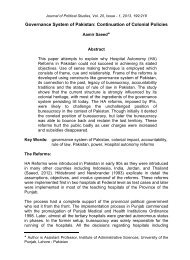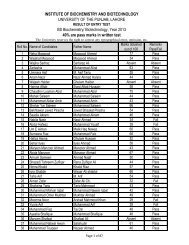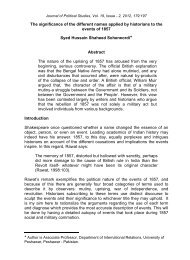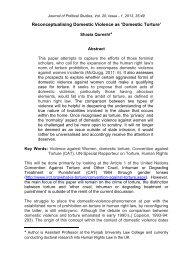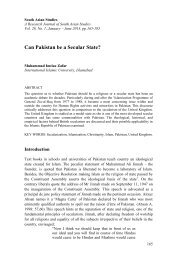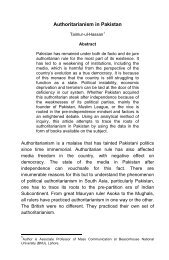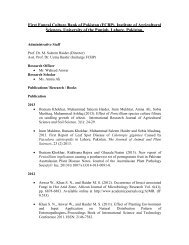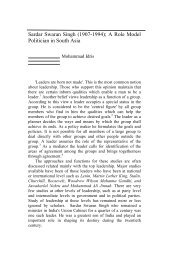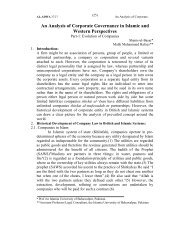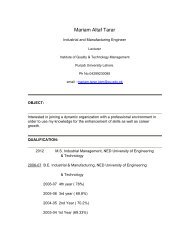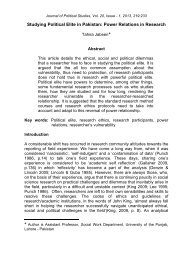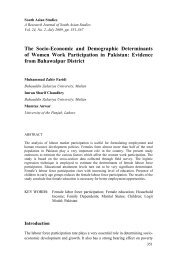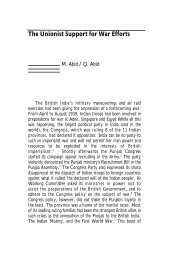pakistan geographical review 1954 - University of the Punjab
pakistan geographical review 1954 - University of the Punjab
pakistan geographical review 1954 - University of the Punjab
Create successful ePaper yourself
Turn your PDF publications into a flip-book with our unique Google optimized e-Paper software.
Rainfall.<br />
In West Pakistan <strong>the</strong>re is a general deficiency <strong>of</strong> rainfall. It varies from<br />
5" in upper Sind to about 30"-35// in <strong>the</strong> sub-montane area. In Baluchistan<br />
<strong>the</strong> mean annual rainfall is 8.1" diminishing to less than 3 inches in <strong>the</strong> desert<br />
<strong>of</strong> Khar an. Only on <strong>the</strong> sou<strong>the</strong>rn flanks <strong>of</strong> <strong>the</strong> Himalayas it exceeds 50". In <strong>the</strong><br />
nor<strong>the</strong>rn mountain region, in <strong>the</strong> lee <strong>of</strong> <strong>the</strong> Great Himalayas <strong>the</strong> rainfall<br />
decreases to about 6 inches in Gilgit and Baltistan. In <strong>the</strong> western hills <strong>the</strong><br />
amount is comparatively greater and varies from 10" to 30".<br />
;.. large portion <strong>of</strong> <strong>the</strong> precipitation in <strong>the</strong> mountainous region is in <strong>the</strong><br />
form <strong>of</strong> snow which is an important element in <strong>the</strong> economy <strong>of</strong> <strong>the</strong>se regions.<br />
The water derived from melting snow in summer is <strong>of</strong> great use in this season as<br />
it keeps <strong>the</strong> Karnes (sub-terranean canals) running. Without this water <strong>the</strong>y<br />
should have been quite dry.<br />
In contrast, practically nowhere in East Pakistan <strong>the</strong> rainfall is less<br />
than 50" and is generally over 70/'. In <strong>the</strong> coastal belt and <strong>the</strong> sub-Himalayan<br />
areas it exceeds 100". In <strong>the</strong> sub-montane <strong>of</strong> <strong>the</strong> Assam hills it averages<br />
between 200" and 250". The lowest annual rainfall is 47.19'/ at Lalpur in<br />
<strong>the</strong> district <strong>of</strong> Rajshahi and <strong>the</strong> highest is 255.76// at Lallakhel in <strong>the</strong><br />
district <strong>of</strong> Sylhet. It will be seen that while West Pakistan is dry, <strong>the</strong> whole<br />
<strong>of</strong> East Pakistan may be termed wet, its lowest rainfall means almost correspondence<br />
with <strong>the</strong> highest means in West Pakistan.<br />
RAINFALL IN INCHES<br />
West Pakistan.<br />
Station Winter Spring Late Autumn Annual<br />
early summer<br />
Summer<br />
Dec-Febr. 111. arch-1'fl ay June-Sept. Oct-Nov.<br />
Karachi 1.1 .50 6.00 .1 7.7<br />
Multan .99 1.00 4.92 .14 7.05<br />
Sia kat 4.35 3.5 23.47 .51 31.83<br />
Peshawar 3.64 4.97 4.41 .54 13.56<br />
Gilgit .6~ 2.56 1.71 .29 5.18<br />
QUf'tta 4.93 3.11 1.00 .4 9.44<br />
Nokkundi 1.43 .49 0.0 .03 1.95<br />
East Pakistan<br />
Cox's Bazar 1.59 18.43 109.66 10.42 140.10<br />
Ncakhali 1.50 19.29 84.55 9.66 115.00<br />
N arayanganj 1.76 17.43 48.38 6.22 73.79<br />
Sylhet 2,48 36.75 87.40 8.82 135.45<br />
Dinajpur 1.03 10.17 1)5.87 5.19 72.26<br />
Jessore 1.85 13.58 43.96 5.54 64.93<br />
6



